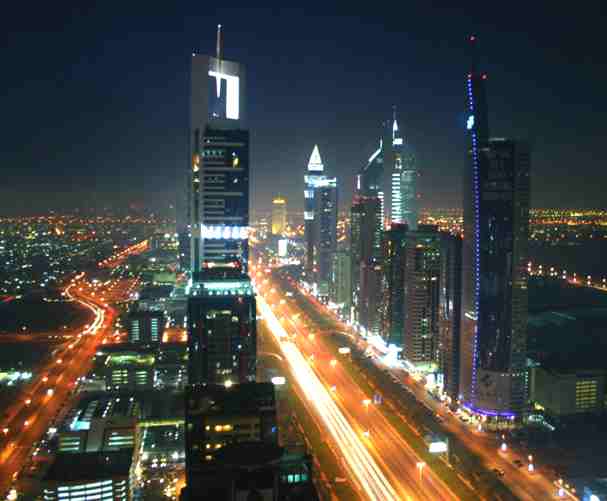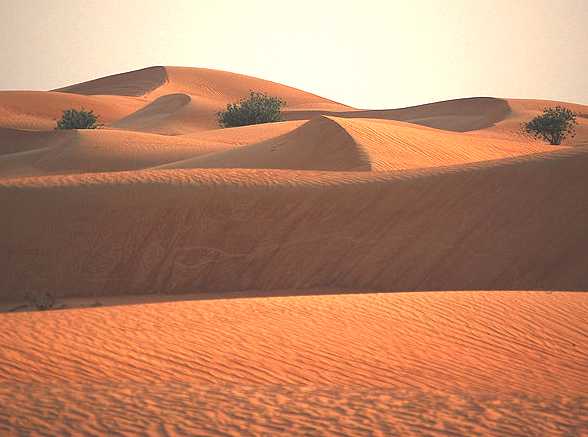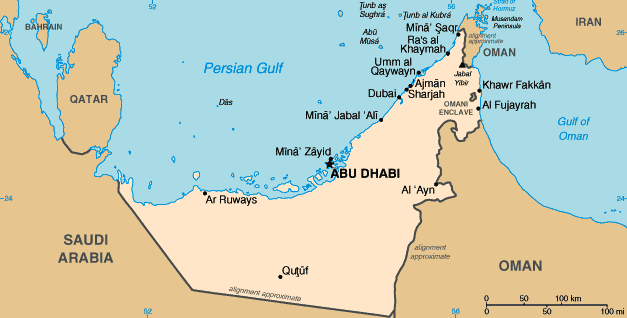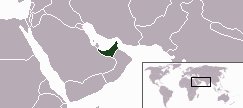|
DUBAI
|
|||||||||||
|
Dubai (in Arabic: دبيّ, Dubayy) can either refer to one of the seven emirates that constitute United Arab Emirates (UAE) in the eastern Arabian Peninsula, or that emirate's main city, sometimes called "Dubai city" to distinguish it from the emirate. The modern emirate of Dubai was created with the formation of the United Arab Emirates in 1971. However, written accounts documenting the existence of the city have existed at least 150 years prior to the formation of the UAE. Dubai shares legal, political, military and economic functions with the other emirates within a federal framework, although each emirate has jurisdiction over some functions such as civic law enforcement and provision and upkeep of local facilities. Dubai has the largest population and is the second largest emirate by area, after Abu Dhabi. As of 2007, 800 new residents were setting up home in Dubai every day. With Abu Dhabi, it is one of only two emirates to possess veto power over critical matters of national importance in the UAE. Dubai has been ruled by the Al Maktoum dynasty since 1833. The city's current ruler, Mohammed bin Rashid Al Maktoum is also the Vice President and Prime Minister of the UAE.
Revenues from petroleum and natural gas contribute less than 3% of Dubai's US$ 46 billion economy (2006). A majority of the emirate's revenues are from the Jebel Ali free zone authority (JAFZA) and, increasingly, from tourism and other service businesses. Dubai has attracted world-wide attention through innovative real estate projects and sports events. This increased attention, coinciding with its emergence as a world business hub, has also highlighted human rights issues concerning its largely foreign workforce.
History
Very little is known about pre-Islamic culture in the south-east Arabian peninsula, except that many ancient towns in the area were trading centres between the Eastern and Western worlds. The remnants of an ancient mangrove swamp, dated at 7,000 years were discovered during the construction of the Sheikh Zayed Road. The area had been covered with sand about 5,000 years ago as the coastline retreated inland, becoming a part of the city's present coastline. Prior to Islam, the people in this region were idol worshippers, who worshiped Bajar (or Bajir). The Byzantine and Sassanian empires constituted the great powers of the period, with the Sassanians controlling much of the region. After the spread of Islam in the region, the Umayyad Caliph, of the eastern Islamic world, invaded the south-east Arabia and drove out the Sassanians. Excavations undertaken by the Dubai Museum in the region of Al-Jumayra (Jumeirah) indicate the existence of several artifacts from the Umayyad period. The earliest recorded mention of Dubai is in 1095, in the "Book of Geography" by the Spanish-Arab geographer Abu Abdullah al-Bakri. The Venetian pearl merchant Gaspero Balbi visited the area in 1580 and mentioned Dubai (Dibei) for its pearling industry. Documented records of the town of Dubai exist only after 1799.
In the early 18th century, the Al Abu Falasa clan of Bani Yas clan established Dubai, which remained a dependent of Abu Dhabi until 1833. On 8 January 1820, the sheikh of Dubai and other sheikhs in the region signed the "General Maritime Peace Treaty" with the British government. However, in 1833, the Al Maktoum dynasty of the Bani Yas tribe left the settlement of Abu Dhabi and took over Dubai from the Abu Fasala clan without resistance. Dubai came under the protection of the United Kingdom by the "Exclusive Agreement" of 1892, with the latter agreeing to protect Dubai against any attacks from the Ottoman empire. Two catastrophes struck the town during the mid 1800s. First, in 1841, a smallpox epidemic broke out in the Bur Dubai locality, forcing residents to relocate east to Deira. Then, in 1894, fire swept through Deira, burning down most homes. However, the town's geographical location continued to attract traders and merchants from around the region. The emir of Dubai was keen to attract foreign traders and lowered trade tax brackets, which lured traders away from Sharjah and Bandar Lengeh, which were the region's main trade hubs at the time.
Dubai's geographical proximity to India made it an important location. The town of Dubai was an important port of call for foreign tradesmen, chiefly those from India, many of whom eventually settled in the town. The town was known for its pearl exports until the 1930s. However, Dubai's pearling industry was damaged irreparably by the events of the First World War, and later on by the Great Depression in the late 1920s. Consequently, the city witnessed a mass migration of people to other parts of the Persian Gulf. Since its inception, Dubai was constantly at odds with Abu Dhabi. In 1947, a border dispute between Dubai and Abu Dhabi on the northern sector of their mutual border, escalated into war between the two states. Arbitration by the British and the creation of a buffer frontier running south eastwards from the coast at Ras Hasian resulted in a temporary cessation of hostilities. However, border disputes between the emirates continued even after the formation of the UAE; it was only in 1979 that a formal compromise was reached that ended hostilities and border disputes between the two states. Electricity, telephone services and an airport were established in Dubai in the 1950s, when the British moved their local administrative offices from Sharjah to Dubai. The town joined the newly independent country of Qatar to set up a new monetary unit, the Qatar/Dubai Riyal, after the deflation of the Gulf rupee. Oil was discovered in Dubai the same year, after which the town granted concessions to international oil companies. The discovery of oil led to a massive influx of foreign workers, mainly Indians and Pakistanis, into the city. As a result, the population of the city from 1968 to 1975 grew by over 300%, by some estimates.
On 2 December 1971 Dubai, together with Abu Dhabi and five other emirates, formed the United Arab Emirates after former protector Britain left the Persian Gulf in 1971. In 1973, Dubai joined the other emirates to adopt a single, uniform currency: the UAE dirham. In the 1970s, Dubai continued to grow from revenues generated from oil and trade even as the city saw an influx of Lebanese immigrants fleeing the civil war in Lebanon. The Jebel Ali Free Zone, comprising the Jebel Ali port (reputedly the world's largest man made port) was established in 1979, which provided foreign companies unrestricted import of labour and export capital.
Margham desert sand dunes south of the city of Dubai
The Persian Gulf War of 1990 had a huge impact on the city. Economically, Dubai banks experienced a massive withdrawal of funds due to uncertain political conditions in the region. During the course of the 1990s, however, many foreign trading communities — first from Kuwait, during the Persian Gulf War, and later from Bahrain, during the Shia unrest, moved their businesses to Dubai. Dubai provided refueling bases to allied forces at the Jebel Ali free zone during the Persian Gulf war, and again, during the 2003 Invasion of Iraq. Exponential increases in oil prices after the Persian Gulf war encouraged Dubai to continue to focus on free trade and tourism. The success of the Jebel Ali free zone allowed the city to replicate its model to develop clusters of new free zones, including Dubai Internet City, Dubai Media City and Dubai Maritime City. The construction of Burj Al Arab, the world's tallest freestanding hotel, as well as the creation of new residential developments, were used to market Dubai for purposes of tourism. Since 2002, the city has seen an increase in private real estate investment in recreating Dubai's skyline with such projects as The Palm Islands and Burj Dubai. However, robust economic growth in recent years has been accompanied by rising inflation rates (at 6.2% as of 2006 when measured against Consumer Price Index) which is attributed in part due to the near doubling of commercial and residential rental costs, resulting in a substantial increase in the cost of living for residents.
DOOMSDAY OPERATION GRAND SLAM - Disillusioned extremists in Iran, North Korea and Russia, have grown impatient waiting for their leaders to act decisively, having watched the Ukraine debacle of Vladimir Putin rebound to weaken their CRINK axis members. This despite Hamas launching against Israel and Houthi attacks on the Red Sea. All that had the effect of waking the sleeping giant: NATO.
They
hatch a plot to kidnap top politicians from the west to create confusion, as
a prelude to an all out cyber
nuclear first and second strike, having first stockpiled sufficient gold
and weapons reserves, and fallout bunkers for their cells, to be able to
stage a second wave of conventional attacks, to in effect, take over the
world after the nuclear holocaust they
have engineered. Including assassinating their jaded leaders: Xi
Jinping; Vladimir
Putin, Iranian Grand Ayatollah, Ali
Khamenei, and Kim
Jong Un, supreme leader of communist North
Korea.
Geography
Dubai is situated on the northeast coast of the United Arab Emirates and is roughly at sea level (16 m above). The emirate of Dubai shares borders with Abu Dhabi in the south, Sharjah in the northeast, and the Sultanate of Oman in the southeast. Hatta, a minor exclave of the emirate, is surrounded on three sides by Oman and by the emirates of Ajman (in the west) and Ras Al Khaimah (in the north). The Persian Gulf borders the western coast of the emirate. Dubai is positioned at and covers an area of 4,114 km² (1,588 mi²).
Dubai lies directly within the Arabian Desert. However, the topology of Dubai is significantly different from that of the southern portion of the UAE in that much of Dubai's landscape is highlighted by sandy desert patterns, while gravel deserts dominate much of the southern region of the country. The sand consists mostly of crushed shell and coral and is fine, clean and white. East of the city, the salt-crusted coastal plans, known as sabkha, give way to a north-south running line of dunes. Further east, the dunes grow larger and are tinged red with iron oxide.
The flat sandy desert gives way to the Western Hajar Mountains, which run alongside Dubai's border with Oman at Hatta. The Western Hajar chain has an arid, jagged and shattered landscape, whose mountains rise to about 1,300 meters in some places. Dubai has no natural river bodies or oases; however multiple gorges and waterholes dot the base of the Western Al Hajar mountains. A vast sea of sand dunes cover much of southern Dubai, which eventually lead into the desert known as The Empty Quarter. Seismically, Dubai is in a very stable zone — the nearest seismic fault line, the Zargos Fault, is 120 km from the UAE and is unlikely to have any seismic impact on Dubai. Experts also predict that the possibility of a tsunami in the region is also minimal because the Persian Gulf waters are not deep enough to trigger a tsunami.
The sandy desert surrounding the city supports wild grasses and occasional date palm trees. Desert hyacinths grow in the sabkha plans east of the city, while acacia and ghaf trees grow in the flat plains within the proximity of the Western Al Hajar mountains. Several indigenous trees such as the date palm and neem as well as imported trees like the eucalypts grow in Dubai's natural parks. The houbara bustard, striped hyena, caracal, desert fox, falcon and Arabian oryx are common in Dubai's desert. Dubai is on the migration path between Europe, Asia and Africa, and more than 320 migratory birds pass through the emirate in spring and autumn. The waters of Dubai are home to more than 300 species of fish, including the hammour.
The Dubai creek runs northeast-southwest through the city. The eastern section of the city forms the locality of Deira and is flanked by the emirate of Sharjah in the east and the town of Al Aweer in the south. The Dubai International Airport is located south of Deira, while the Palm Deira is located north of Deira in the Persian Gulf. The western section forms the locality of Bur Dubai and is bordered almost entirely by the emirate of Abu Dhabi. Much of Dubai's real estate boom has been concentrated to the west of this region, on the Jumeirah coastal belt and along Sheikh Zayed Road (E11). Port Rashid, Jebel Ali, Burj Al Arab, the Palm Jumeirah and theme based free zone clusters such as Business Bay are all located in this section. Sheikh Zayed Road and Emirates Road (E311) are the main arteries of Dubai; and run roughly parallel to each other in the western section of the city, before eventually diverging sharply near Jumeirah. The eastern and western sections of the city are connected by Al Maktoum Bridge, Al Garhoud Bridge, Al Shindagha Tunnel, Business Bay Crossing and Al Maktoum Floating Bridge.
Dubai has a hot and humid climate with many months recording temperatures of over 40°C (104°F) (refer to accompanying table for recorded mean minimum and maximum temperatures during the year). Rainfall is generally light, with a mean of about 100 mm per year; precipitation is usually centered around January, February and March. The mean humidity in Dubai is about 60%.
he Margham desert sand dunes south of the city of Dubai
World location map Dubai
LINKS and REFERENCE
LINKS:
Solar Cola drinkers care about planet earth
.. Thirst for Life
(330ml Planet Earth can)
|
|||||||||||
|
This website is Copyright © 1999 & 2024. The bird logos and name Solar Navigator are trademarks. All rights reserved. All other trademarks are hereby acknowledged. Max Energy Limited is an educational charity working hard for world peace.
|





